Assessment of Gas Production from Complex Hydrate System in Qiongdongnan Basin of South China Sea
Abstract
:1. Introduction
2. Geological Background and Model
3. Mathematical Model
3.1. Material Conservation Equation
3.2. Energy Conservation Equation
3.3. Kinetic Equation of Hydrate Formation and Dissociation
3.4. Dynamic Equation of Permeability and Porosity
4. Evaluation Criteria
5. Simulation Results and Discussion
5.1. Site 1 Simulation Result
5.2. Site 2 Simulation Result
5.3. Site 3 Simulation Results
5.4. Site 4 Simulation Results
5.5. Site 5 Simulation Results
6. Summary
- Except for Site 1, the simulation results of all the other sites show that the complex hydrate system in QDNB has commercial development potential. The system is highly inhomogeneous in the transversal direction. Different sites have different production characteristics. The cumulative gas production volume from Site 3 and Site 5 can reach approximately 6 × 108 m3 in 9 years. The production capacity is based on the free gas zone with high saturation and high permeability in the system. Especially in the preliminary stage, it is an important support for gas production and a significant channel for pressure diffusion. The wellhead gas rate from hydrate dissociation starts to rise in the middle stage when the free gas recovery is nearly completed. The hydrate dissociation can extend the duration of stable production and increase the extraction life of the gas-hydrate system.
- The producer well in the highly saturated hydrate zone at Site 1 is far away from the free gas. The hydrate-filled pore causes a very low effective permeability and slow pressure diffusion. The free gas cannot invade the hydrate zone and support gas production. All the gas produced is from hydrate dissociation. Coupled with the fact that the reservoir itself is thin and no innovative production enhancements are used to drive rapid hydrate dissociation, the hydrate zone at Site 1 cannot obtain commercial gas flow by depressurization. The 9-year cumulative production volume is only 7.25 × 106 m3. Therefore, Site 1 can only be used as a scientific trial field.
- The producer well at Site 2 is near the edge of the hydrate zone and close to the transition zone. With the large pressure differential, the free gas from the lower part of the transition zone can effectively invade the hydrate zone and enter the wellbore in the short term. The elastic energy of gas can quickly drive the water of the hydrate zone into the well, making the rapid hydrate dissociation in the gas-affected area. After the breakup of free gas, the gas rate can be increased, and the peak gas rate reaches 32 × 104 m3/d. However, the intensity of hydrate dissociation is insufficient. Although the ultimate ratio of instantaneous gas rate can climb to more than 40%, the cumulative gas production volume from hydrate accounts for only 12.3%.
- As for the well of the sites in the transition zone, it directly invokes the free gas capacity. Free gas is produced as the formation pressure reduces and hydrate is induced to dissociate, making the gas from the hydrate the subsequent production capacity. For example, with the initial stable production rate of 30 × 104 m3/d at Site 3, the cumulative gas volume at the wellhead from hydrate can reach 1.73 × 108 m3, and the total gas volume is 6.1 × 108 m3. Due to the high quality of the free gas zone, the smooth gas flow channel is ensured, and the recovery rate of free gas from a single vertical well is close to 90%, which can meet the commercial development demand. The cumulative gas production volume from hydrate accounts for up to 29.9%. Notably, any producer well laid above the water zone would result in a 40% increase in water production and a decrease in stable production length. Avoiding the water layer in developing a hydrate system of this type is recommended.
- The producer well built in the gas zone (Site 5) can acquire the longest stable production duration. The well is far away from the hydrate zone, so the gas rate from the hydrate rises very slowly. After the recovery of free gas is nearly completed, the gas rate from hydrate begins to rise significantly. The water output at this site is small. Building a single vertical well in the gas zone is recommended to exploit the complex hydrate system of QDNB.
- A single vertical well still faces the defect of a small control area when facing a large area of an inhomogeneous reservoir. The control here means the ability to collect the gas produced by hydrate. The simulation found that the “water belt” is easy to form after the hydrate dissociation, which hinders the transport of dissociated gas into the well. In the future, we can try to exploit these hydrate systems with the well group to improve the utilization rate of hydrate.
- There are definitely some limitations in the assessment. The amount of in situ core is scarce. The key parameters of the geological model cannot be examined by pressure-preserving core experiments, such as saturation and permeability. The geological model needs further validation and improvement. In addition, the in situ formation mechanical test has not been carried out. The mechanical properties are not considered seriously in the simulation. It is generally known that, for shallow hydrate reservoirs, the porosity will be reduced due to the increase in the effective stress, which will affect the efficiency of gas production if the formation fails. Therefore, the assessment in this paper is actually an optimistic result.
- There are many such complex hydrate systems with hydrate-gas mixing in the QDNB, including surveyed and unproven. The CGS will increase the survey efforts and the number of cores in the future. More experiments on the flow characteristics of in-situ hydrate layers must be carried out to improve the accuracy of capacity assessment.
7. Conclusions
- The discovered complex hydrate system in the QDNB, with gas and hydrate distributing in the same layer, has commercial development potential.
- The simulation results show that wells located in the transition and gas zones have significant gas production capacity. To this single deposit, the maximum stable production duration with a gas rate of 20 × 104 m3/d can last more than 2600 days.
- The hydrate dissociation can extend the duration of stable production and increase the extraction life of such a gas-hydrate system—the cumulative gas production volume from hydrate accounts for up to 29.9%.
- The well in the highly saturated hydrate zone has a limited gas production capacity. The low effective permeability and slow pressure diffusion make that unfavorable result. This innovative simulation method should be used to further improve the contribution from hydrate dissociation.
Author Contributions
Funding
Data Availability Statement
Conflicts of Interest
References
- Sloan, E.D. Fundamental principles and applications of natural gas hydrates. Nature 2003, 426, 353–359. [Google Scholar] [CrossRef] [PubMed]
- Cherskiy, V.P.; Tsarev, V.P.; Nikitin, S.P. Investigation and prediction of conditions of accumulation of gas resource in gas-hydrate pools. Pet. Geol. 1984, 21, 84–89. [Google Scholar]
- Kvenvolden, K.A.; Lorenson, T.D. The global occurrence of natural gas hydrate. Geophys. Monogr. 2001, 124, 87–98. [Google Scholar] [CrossRef]
- Dallimore, S.R.; Uchida, T.; Collett, T.S. Scientific results from JAPAX/JNOC/GSC Mallik 2L-38 gas hydrate research well, Mackenzie Delta, Northwest Territories, Canada. Geol. Surv. Can. Bull. 1999, 544, 295–311. [Google Scholar]
- Liu, C.L.; Meng, Q.G.; He, X.L.; Li, C.F.; Ye, Y.G.; Lu, Z.Q.; Zhu, Y.H.; Li, Y.H.; Liang, J.Q. Comparison of the characteristics for natural gas hydrate recovered from marine and terrestrial areas in China. J. Geochem. Explor. 2015, 152, 67–74. [Google Scholar] [CrossRef]
- Fang, H.; Xu, M.C.; Lin, Z.Z.; Zhong, Q.; Bai, D.W.; Liu, J.X.; Pei, F.G.; He, M.X. Geophysical characteristics of gas hydrate in the Muli area, Qinghai province. J. Nat. Gas Sci. Eng. 2017, 37, 539–550. [Google Scholar] [CrossRef]
- Schicks, J.M.; Haeckel, M.; Janicki, G.; Spangenberg, E.; Thaler, J.; Giese, R.; Strauch, B.; Heeschen, K.; Priegnitz, M.; Luzi-Helbing, M.; et al. Development, test, and evaluation of exploitation technologies for the application of gas production from natural gas hydrate reservoirs and their potential application in the Danube Delta, Black Sea. Mar. Pet. Geol. 2020, 120, 104488. [Google Scholar] [CrossRef]
- Ewa, B.; Matthias, H. Basin-scale estimates on the petroleum components generation in the Western Black Sea basin based on the 3-D numerical model. Mar. Pet. Geol. 2019, 113, 104122. [Google Scholar] [CrossRef]
- Chazallon, B.; Rodriguez, C.T.; Ruffine, Y.; Carpentier, Y.; Riboulot, Y. Characterizing the variability of natural gas hydrate composition from a selected site of the Western Black Sea, off Romania. Mar. Pet. Geol. 2020, 124, 104785. [Google Scholar] [CrossRef]
- Konno, Y.; Fujii, T.; Sato, A.; Akamine, K.; Naiki, M.; Masuda, Y.; Yamamoto, K.; Nagao, J. Key findings of the world’s first offshore methane hydrate production test off the coast of Japan: Toward future commercial production. Energy Fuels 2017, 31, 2607–2616. [Google Scholar] [CrossRef]
- Tamaki, M.; Fujii, T.; Suzuki, K. Characterization and prediction of the gas hydrate reservoir at the second offshore gas production test site in the eastern Nankai Trough, Japan. Energies 2017, 10, 1678. [Google Scholar] [CrossRef]
- Yoon, S.H.; Sohn, Y.K.; Chough, S.K. Tectonic, sedimentary, and volcanic evolution of a back-arc basin in the East Sea (Sea of Japan). Mar. Geol. 2014, 352, 70–88. [Google Scholar] [CrossRef]
- Wang, X.J.; Collett, T.S.; Lee, M.W.; Yang, S.X. Geological controls on the occurrence of gas hydrate from core, downhole log, and seismic data in the Shenhu area, South China Sea. Mar. Geol. 2014, 357, 272–292. [Google Scholar] [CrossRef]
- Yu, X.H.; Wang, J.Z.; Liang, J.Q.; Li, S.L.; Kuang, Z.G.; Li, W. Depositional characteristics and accumulation model of gas hydrates in northern South China Sea. Mar. Pet. Geol. 2014, 56, 74–86. [Google Scholar] [CrossRef]
- Klauda, J.B.; Sandler, S.I. Global distribution of methane hydrate in ocean sediment. Energy Fuels 2005, 19, 459–470. [Google Scholar] [CrossRef]
- Makogon, Y.F. Natural gas hydrates—A promising source of energy. J. Nat. Gas Sci. Eng. 2010, 2, 49–59. [Google Scholar] [CrossRef]
- Pinero, E.; Marquardt, C.; Hensen, C.; Haeckel, M.; Wallmann, K. Estimation of the global inventory of methane hydrates in marine sediments using transfer functions. Biogeosciences 2013, 10, 959–975. [Google Scholar] [CrossRef]
- Wallmann, K.; Pinero, E.; Burwicz, E.; Haeckel, M.; Ruepke, L. The global inventory of methane hydrate in marine sediments: A theoretical approach. Energies 2012, 5, 2449–2498. [Google Scholar] [CrossRef]
- Oleg, B.; Kateryna, S.; Vasyl, L.; Mykhailo, P.; Pavlo, S. Research into dissociation zones of gas hydrate deposits with a Heterogeneous structure in the Black Sea. Energies 2021, 14, 1345. [Google Scholar] [CrossRef]
- Takahashi, H.; Yonezawa, T.; Fercho, E. Operation Overview of the 2002 Mallik gas hydrate production research well program at the Mackenzie Delta in the Canadian Arctic. In Proceedings of the Offshore Technology Conference, Houston, TX, USA, 5–8 May 2003. [Google Scholar] [CrossRef]
- Moridis, G.J.; Collett, T.S.; Pooladi-Darvish, M.; Hancock, S.H.; Santamarina, C.; Boswell, R.; Kneafsey, T.J.; Rutqvist, J.; Kowalsky, M.B.; Reagan, M.T. Challenges, Uncertainties and Issues Facing Gas Production from Hydrate Deposits in Geologic Systems. In Proceedings of the SPE Unconventional Gas Conference, Pittsburgh, PA, USA, 23–25 February 2010. [Google Scholar] [CrossRef]
- Li, J.F.; Ye, J.L.; Qin, X.W.; Qiu, H.J.; Wu, N.Y.; Lu, H.L.; Xie, W.W.; Lu, J.A.; Peng, F.; Xu, Z.Q.; et al. The first offshore natural gas hydrate production test in South China Sea. China Geol. 2018, 1, 5–16. [Google Scholar] [CrossRef]
- Ye, J.L.; Qin, X.W.; Xie, W.W.; Lu, H.L.; Ma, B.J.; Qiu, H.J.; Liang, J.Q.; Lu, J.A.; Kuang, Z.G.; Lu, C.; et al. Main progress of the second gas hydrate trial production in the South China Sea. Geol. China 2020, 47, 557–568, (In Chinese with English Abstract). [Google Scholar] [CrossRef]
- Uchida, T.; Takeya, S.; Chuvilin, E.M.; Ohmura, R.; Nagao, J.; Yakushev, V.S.; Istomin, V.A.; Minagawa, H.; Hideo-Narita, T.E. Decomposition of methane hydrates in sand, sandstone, clays, and glass beads. J. Geophys Res. 2004, 109, B05206. [Google Scholar] [CrossRef]
- Liu, X.L.; Flemings, P.B. Capillary effects on hydrate stability in marine sediments. J. Geophys. Res. 2011, 116, B07102. [Google Scholar] [CrossRef]
- Daigle, H.; Dugan, B. Pore size controls on the base of the methane hydrate stability zone in the Kumano Basin, offshore Japan. Geophys. Res. Lett. 2014, 41, 8021–8028. [Google Scholar] [CrossRef]
- Li, Z.D.; Tian, X.; Li, Z.; Xu, J.Z.; Zhang, H.X.; Wang, D.J. Experimental study on growth characteristics of pore-scale methane hydrate. Energy Rep. 2020, 6, 933–943. [Google Scholar] [CrossRef]
- Ryu, B.J.; Collett, T.S.; Rield, M.; Kim, G.Y.; Chun, J.H.; Bahk, J.J.; Lee, J.Y.; Kim, J.H.; Yoo, D.G. Scientific results of the Second Gas Hydrate Drilling Expedition in the Ulleung Basin (UBGH2). Mar. Pet. Geol. 2013, 47, 1–20. [Google Scholar] [CrossRef]
- Yoo, D.G.; Kang, N.K.; Yi, B.Y.; Kim, G.Y.; Ryu, B.J.; Lee, K.; Lee, G.H.; Riedel, M. Occurrence and seismic characteristics of gas hydrate in the Ulleung Basin, East Sea. Mar. Pet. Geol. 2013, 47, 236–247. [Google Scholar] [CrossRef]
- Torres, M.E.; Trehu, A.M.; Cespedes, N.; Kastner, M.; Wortmann, U.G.; Kim, J.H.; Long, P.; Malinverno, A.; Pohlman, J.W.; Riedel, M.; et al. Methane hydrate formation in turbidite sediments of northern Cascadia, IODP Expedition 311. Earth Planet. Sci. Lett. 2008, 271, 170–180. [Google Scholar] [CrossRef]
- Boswell, R.; Collett, T.S.; Frye, M.; Shedd, W.; Mcconnell, D.R.; Shelander, D. Subsurface gas hydrates in the northern Gulf of Mexico. Mar. Pet. Geol. 2012, 34, 4–30. [Google Scholar] [CrossRef]
- Santra, M.; Flemings, P.B.; Scott, E. Evolution of gas hydrate-bearing deep-water channel-levee system in abyssal Gulf of Mexico: Levee growth and deformation. AAPG (Am. Assoc. Pet. Geol.) Bull. 2020, 104, 1921–1944. [Google Scholar] [CrossRef]
- Ewa, B.; Thomas, R.; Klaus, W.; Wolf, R.; Matthisa, H.; Christian, H. 3-D basin-scale reconstruction of natural gas hydrate system of the Green Canyon, Gulf of Mexico. Geochem. Geophys. Geosyst. 2017, 18, 1959–1985. [Google Scholar] [CrossRef]
- Yang, S.X.; Zhang, H.Q.; Wu, N.Y.; Su, X.; Schultheiss, P.; Holland, M. High concentration hydrate in disseminated forms obtained in Shenhu area, north slope of south China sea. In Proceedings of the 6th ICGH, Vancouver, BC, Canada, 6–10 July 2008. [Google Scholar]
- Wu, N.Y.; Yang, S.X.; Zhang, H.Q.; Liang, J.Q.; Wang, H.B.; Lu, J.A. Gas hydrate system of Shenhu area, Northern South China Sea: Geochemical results. J. Geol. Res. 2011, 2011, 370298. [Google Scholar] [CrossRef]
- Liu, C.L.; Ye, Y.G.; Meng, Q.G.; He, X.L.; Lu, H.L.; Zhang, J.; Liu, J.; Yang, S.X. The characteristics of gas hydrates recovered from Shenhu area in the South China Sea. Mar. Geol. 2012, 307–310, 22–27. [Google Scholar] [CrossRef]
- Jiang, H.; Su, M.; Lei, X.H.; Kuang, Z.G.; Wu, N.Y.; Liu, L.H.; Yang, R. Distribution of fine-grained turbidites on canyon ridges in the Shenhu area of northern South China Sea and its implications. Mar. Geol. Quat. Geol. 2018, 38, 52–62, (In Chinese with English Abstract). [Google Scholar]
- Chen, F.; Su, X.; Lu, H.F.; Zhou, Y.; Zhang, C. Relations between Biogenic component (foraminifera) and highly saturated hydrates distribution from Shenhu area, northern South China Sea. J. China Univ. Geosci. 2013, 38, 907–915, (In Chinese with English Abstract). [Google Scholar] [CrossRef]
- Lei, G.; Liao, Q.Z.; Patil, S.; Yang, Z. Effect of clay content on permeability behavior of argillaceous porous media under stress dependence: A theoretical and experimental work. J. Pet. Sci. Eng. 2019, 179, 787–795. [Google Scholar] [CrossRef]
- Motoi, O.; Kiyofumi, S.; Jun, Y.; Akira, K.; Masato, K.; Yoshihiro, K.; Michihiro, M.; Yusuke, J.; Jiro, N.; Norio, T. Lithological properties of natural gas hydrate–bearing sediments in pressure-cores recovered from the Krishna-Godavari Basin. Mar. Pet. Geol. 2019, 108, 439–470. [Google Scholar] [CrossRef]
- Zhang, W.; Liang, J.Q.; Lu, J.A.; Wei, J.G.; Su, P.B.; Fang, Y.X.; Guo, Y.Q.; Yang, S.X.; Zhang, G.X. Accumulation features and mechanisms of high saturation natural gas hydrate in Shenhu Area, northern South China Sea. Pet. Explor. Dev. 2017, 44, 708–719. [Google Scholar] [CrossRef]
- Sun, J.X.; Zhang, L.; Ning, F.L.; Lei, H.W.; Liu, T.L.; Hu, G.W.; Lu, H.L.; Lu, J.A.; Liu, C.L.; Jiang, G.S.; et al. Production potential and stability of hydrate-bearing sediments at the site GMGS3-W19 in the South China Sea: A preliminary feasibility study. Mar. Pet. Geol. 2017, 86, 447–473. [Google Scholar] [CrossRef]
- Cai, J.C.; Xia, Y.X.; Lu, C.; Bian, H.; Zou, S.M. Creeping microstructure and fractal permeability model of natural gas hydrate reservoir. Mar. Pet. Geol. 2020, 115, 104282. [Google Scholar] [CrossRef]
- Yu, L.; Zhang, L.; Zhang, R.; Ren, S.R. Assessment of natural gas production from hydrate-bearing sediments with unconsolidated argillaceous siltstones via a controlled sandout method. Energy 2018, 160, 654–667. [Google Scholar] [CrossRef]
- Yao, B.C.; Zeng, W.J.; Hayes, D.E. Special Report on China-US Cooperation in the South China Sea Geology; China University of Geosciences Press: Wuhan, China, 1994; pp. 51–52. [Google Scholar]
- Zhao, Z.X.; Sun, Z.; Wang, Z.F.; Sun, Z.P.; Liu, J.B.; Zhang, C.M. The high-resolution sedimentary filling in Qiongdongnan Basin, northern south China Sea. Mar. Geol. 2015, 361, 11–24. [Google Scholar] [CrossRef]
- Wei, J.G.; Liang, J.Q.; Lu, J.A.; Zhang, W.; He, Y.L. Characteristics and dynamics of gas hydrate systems in the northwestern South China Sea-Results of the fifth gas hydrate drilling expedition. Mar. Pet. Geol. 2019, 110, 287–298. [Google Scholar] [CrossRef]
- Ye, J.L.; Wei, J.G.; Liang, J.Q.; Lu, J.A.; Lu, H.L.; Zhang, W. Complex gas hydrate system in a gas chimney, South China Sea. Mar. Pet. Geol. 2019, 104, 29–39. [Google Scholar] [CrossRef]
- Liang, J.Q.; Zhang, W.; Lu, J.A.; Wei, J.G.; Kuang, Z.K.; He, Y.L. Geological occurrence and accumulation mechanism of natural gas hydrates in the eastern Qiongdongnan Basin of the South China Sea: Insights from site GMGS5-W9–2018. Mar. Geol. 2019, 418, 106042. [Google Scholar] [CrossRef]
- Meng, M.M.; Liang, J.Q.; Lu, J.A.; Zhang, W.; Kuang, Z.K.; Fang, Y.X.; He, Y.L.; Deng, W.; Huang, W. Quaternary deep-water sedimentary characteristics and their relationship with the gas hydrate accumulations in the Qiongdongnan Basin, Northwest South China Sea. Deep Sea Res. Part I 2021, 177, 103628. [Google Scholar] [CrossRef]
- Cook, A.E.; Goldberg, D.; Kleinberg, R.L. Fracture-controlled gas hydrate systems in the northern Gulf of Mexico. Mar. Pet. Geol. 2008, 25, 932–941. [Google Scholar] [CrossRef]
- Riedel, M.; Collett, T.S.; Kumar, P.; Sathe, A.V.; Cook, A. Seismic imaging of a fractured gas hydrate system in the Krishna–Godavari Basin offshore India. Mar. Pet. Geol. 2010, 27, 1476–1493. [Google Scholar] [CrossRef]
- Zhang, W.; Liang, J.Q.; Lu, J.A.; Meng, M.M.; He, Y.L.; Deng, W.; Feng, J.X. Characteristics and controlling mechanism of typical leakage gas hydrate reservoir forming system in the Qiongdongnan Basin, northern South China Sea. Nat. Gas Ind. 2020, 40, 90–99, (In Chinese with English Abstract). [Google Scholar] [CrossRef]
- He, Y.L.; Liang, J.Q.; Shi, W.Z.; Kuang, Z.K.; Deng, W.; Wang, R.; Xu, L.T.; Du, H. Influencing factors and accumulation modes of gas hydrate in the South low uplift and its surrounding area of Qiongdongnan Basin. Earth Sci. 2021, 5, 1711–1727, (In Chinese with English Abstract). [Google Scholar] [CrossRef]
- Xie, Y.H.; Zhang, G.C.; Sun, Z.P.; Zeng, Q.; Zhao, Z.; Guo, S. Reservoir forming conditions and key exploration technologies of Lingshui 17–2 giant gas field in deepwater area of Qiongdongnan Basin. Petrol. Res. 2019, 4, 1–18. [Google Scholar] [CrossRef]
- Zhang, W.; Liang, J.Q.; Su, P.B.; Gong, Y.H.; Lin, L.; Liang, J.; Huang, W. Distribution and characteristics of mud diapirs, gas chimneys, and bottom simulating reflectors associated with hydrocarbon migration and gas hydrate accumulation in the Basin, northern slope of the South China Sea. Geol. J. 2018, 54, 3556–3573. [Google Scholar] [CrossRef]
- Chen, Z.G.; Jiang, T.; Kuang, Z.G.; Chen, C.; Xiong, P.F.; Chen, Y. Accumulation characteristics of gas hydrate-shallow gas symbiotic system in Qiongdongnan Basin. Earth Sci. 2022, 47, 1619–1634, (In Chinese with English Abstract). [Google Scholar] [CrossRef]
- Huang, W.; Zhang, W.; Liang, J.Q.; Shang, J.J.; Meng, M.M.; Shan, C.C. Comparative study of gas hydrate accumulation system in the Qiongdongnan Basin of the South China Sea and the Ulleung Basin of Korea. J. China Uni. Min. Tech. 2020, 50, 363–380, (In Chinese with English Abstract). [Google Scholar] [CrossRef]
- Milkov, A.V. Worldwide distribution of submarine mud volcanoes and associated gas hydrates. Mar. Geol. 2000, 167, 29–42. [Google Scholar] [CrossRef]
- Huang, S.Z.; Li, F.; Song, P.; Hu, B.; Sun, W.Y. Study on geophysical identification technology of ultra deep water and shallow gas reservoirs in Qiongdongnan Basin. Earth Sci. 2022, 339, 1–11, (In Chinese with English Abstract). [Google Scholar]
- Moridis, G.J.; Kowalsky, M.B.; Pruess, K. Depressurization-induced gas production from Class 1 hydrate deposits. SPE J. Res. Eva. Eng. 2007, 10, 458–481. [Google Scholar] [CrossRef]
- Zhu, J.T.; Deng, Y.; Guo, M.G.; Song, P.; Xiong, X.F.; Mao, X.F.; Li, F.; Huang, S.Z.; He, Y.; Ren, T. Mineralization conditions and accumulation pattern of the gas hydrate in Qiongdongnan basin floor plain. China Offshore Oil Gas 2020, 32, 10–19, (In Chinese with English Abstract). [Google Scholar]
- Xue, K.P.; Liu, Y.; Yu, T.; Yang, L.; Zhao, J.F.; Song, Y.C. Numerical simulation of gas hydrate production in shenhu area using depressurization: The effect of reservoir permeability heterogeneity. Energy 2023, 271, 126948. [Google Scholar] [CrossRef]
- Wei, R.P.; Xia, Y.Q.; Wang, Z.F.; Li, Q.P.; Lv, X.; Leng, S.D.; Zhang, L.X.; Zhang, Y.; Xiao, B.; Yang, S.X.; et al. Long-term numerical simulation of a joint production of gas hydrate and underlying shallow gas through dual horizontal wells in the South China Sea. Appl. Energy 2022, 320, 119235. [Google Scholar] [CrossRef]
- Zhao, E.M.; Hou, J.; Du, Q.J.; Liu, Y.G.; JI, Y.K.; Bai, Y.J. Numerical modeling of gas production from methane hydrate deposits using low-frequency electrical heating assisted depressurization method. Fuel 2021, 290, 120075. [Google Scholar] [CrossRef]
- Meret, S.; Al-Raoush, R.I.; Jung, J.W.; Alshibli, K.A. Comprehensive literature review on CH4-CO2 replacement in microscale porous media. J. Pet. Sci. Eng. 2018, 178, 48–62. [Google Scholar] [CrossRef]
- Gajanayake, S.; Gamage, R.P.; Wanniarachchige, P.; Zhang, D. Quantification of CO2 replacement in methane gas hydrates: A molecular dynamics perspective. J. Nat. Gas. Eng. 2022, 98, 104396. [Google Scholar] [CrossRef]
- Li, S.X.; Li, S.; Zhang, R.Y.; Li, Q.P.; Pang, W.X. Strategies for gas production from Class 2 hydrate accumulations by depressurization. Fuel 2021, 286, 119380. [Google Scholar] [CrossRef]
- Moridis, G.J.; Reagan, M.T. Estimating the upper limit of gas production from Class 2 hydrate accumulations in the permafrost: 1. Concepts, system description, and the production base case. J. Pet. Sci. Eng. 2011, 76, 194–204. [Google Scholar] [CrossRef]
- Yang, S.W.; Lang, X.M.; Wang, Y.H.; Wen, Y.G.; Fan, S.S. Numerical simulation of Class 3 hydrate reservoirs exploiting using horizontal well by depressurization and thermal co-stimulation. Energy Convers. Manag. 2014, 77, 298–305. [Google Scholar] [CrossRef]
- Moridis, G.J.; Sloan, E.D. Gas production potential of disperse low-saturation hydrate accumulations in oceanic sediments. Energy Convers. Manag. 2007, 48, 1834–1849. [Google Scholar] [CrossRef]
- Uddin, M.; Coombe, D.; Law, D.; Gunter, B. Numerical studies of gas hydrate formation and decomposition in a geological reservoir. In Proceedings of the SPE Gas Technology Symposium, Calgary, AB, Canada, 15–18 May 2006. [Google Scholar] [CrossRef]
- Vysniauskas, A.; Bishnoi, P.R. A kinetic study of methane hydrate formation. Chem. Eng. Sci. 1983, 38, 1061–1072. [Google Scholar] [CrossRef]
- Kim, H.C.; Bishnoi, P.R.; Heidemann, R.A.; Rizvi, S.S.H. Kinetics of methane hydrate decomposition. Chem. Eng. Sci. 1987, 42, 1645–1653. [Google Scholar] [CrossRef]
- Carman, P.C. Fluid flow through granular beds. Trans. Inst. Chem. Eng. 1937, 15, 150–166. [Google Scholar] [CrossRef]
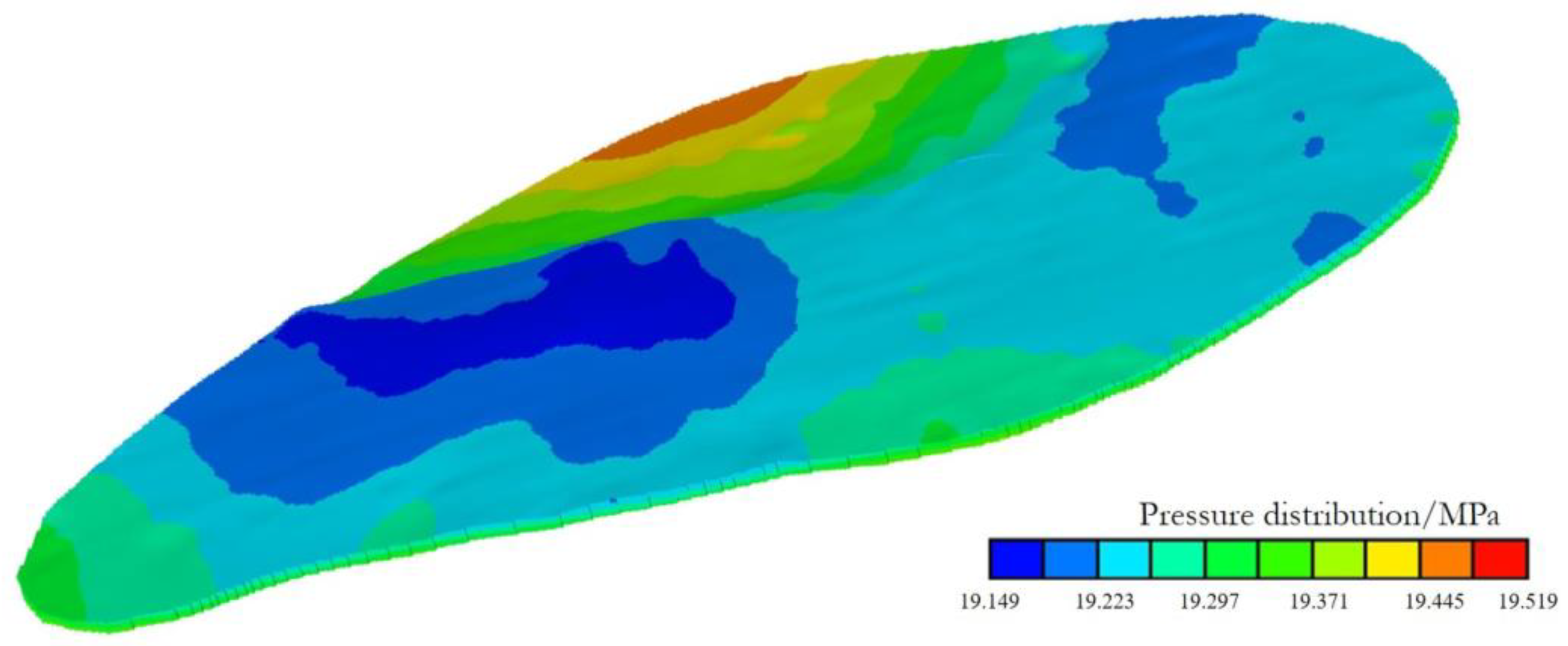





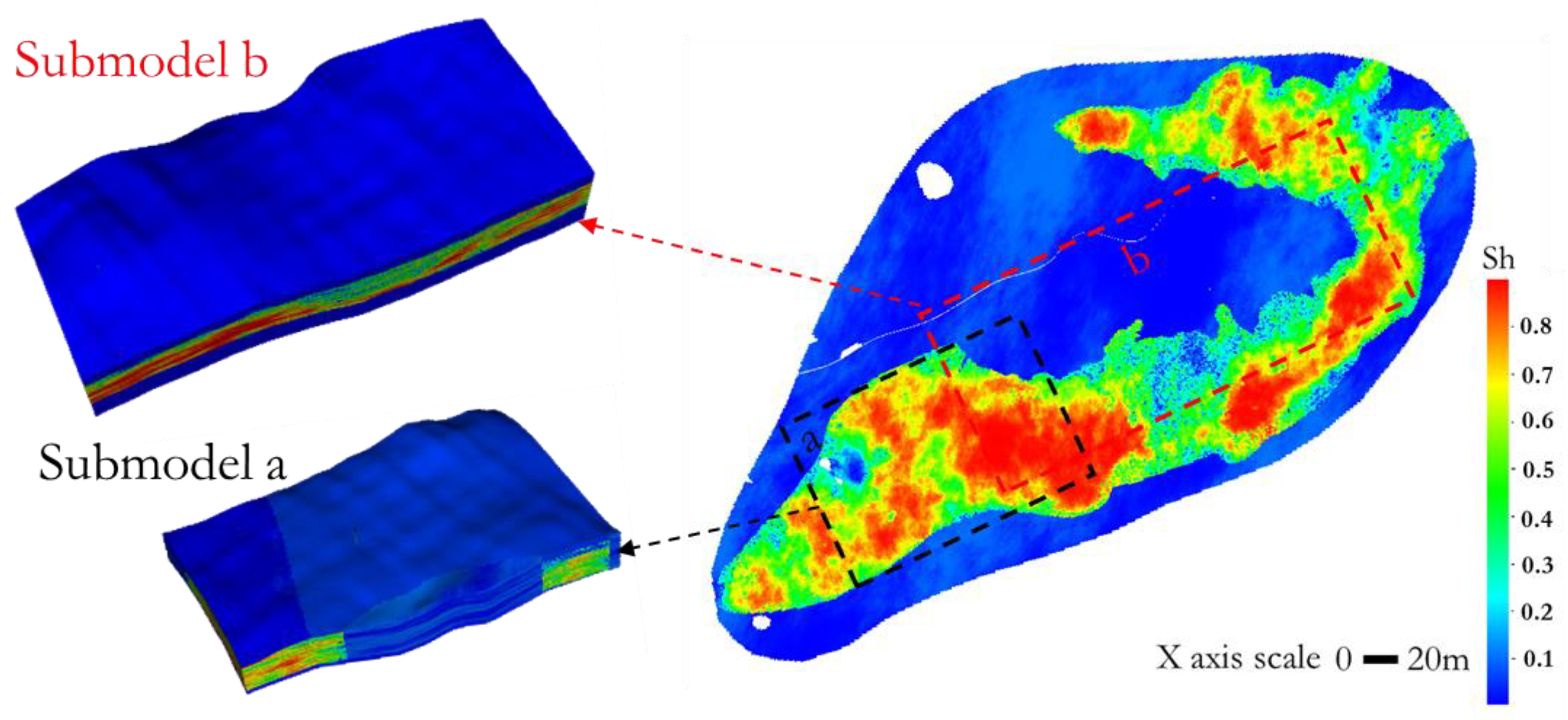


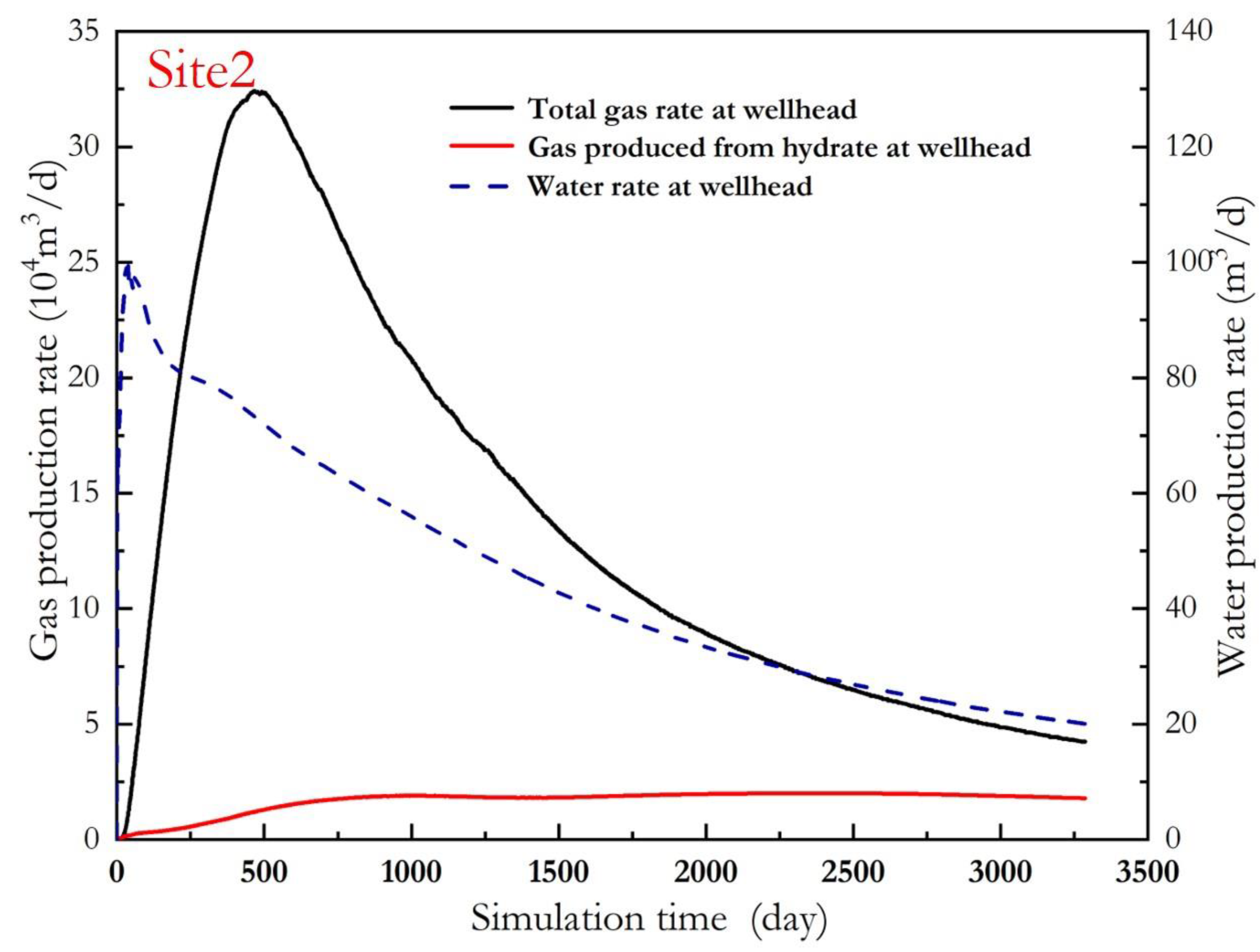







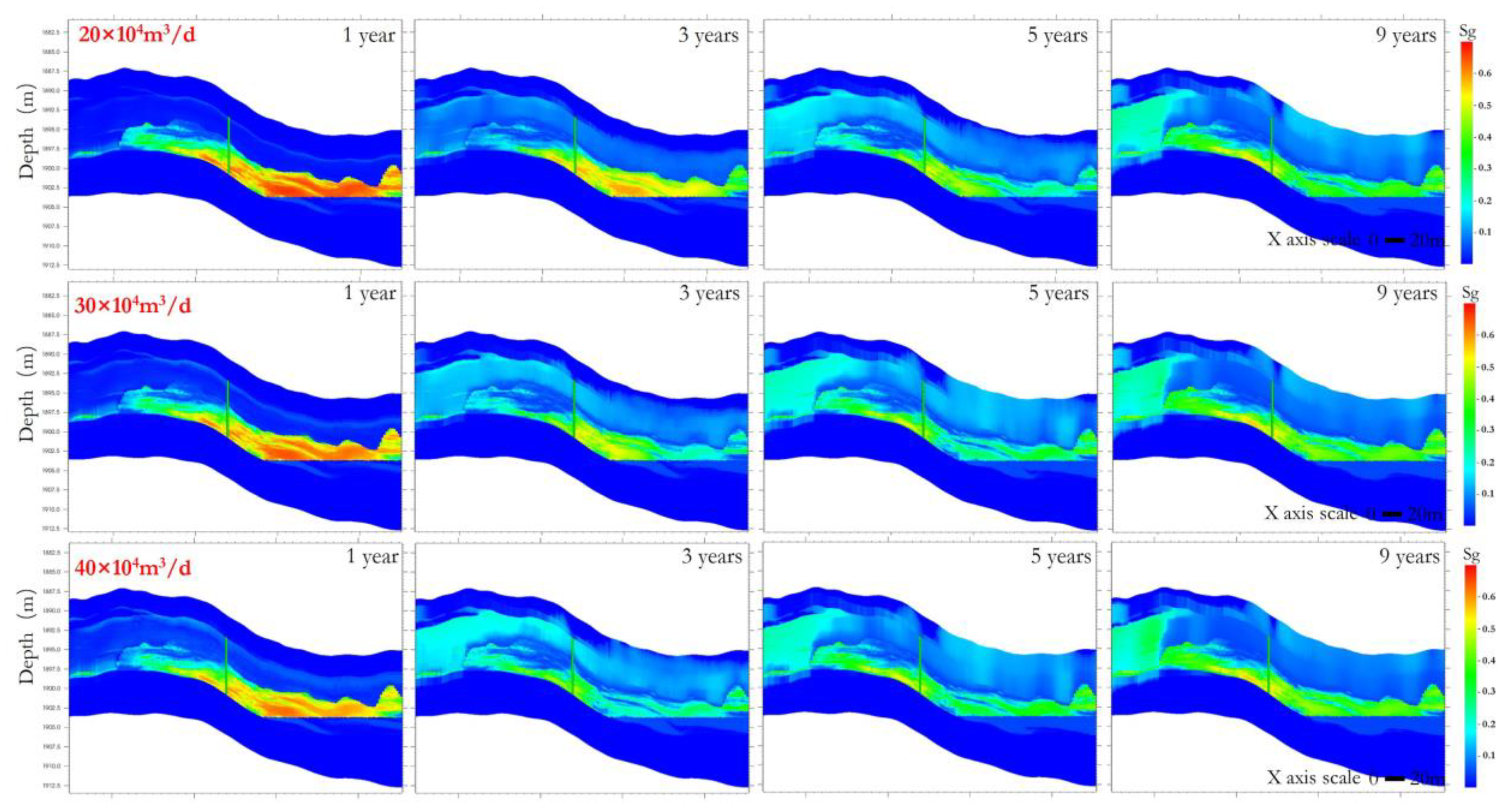


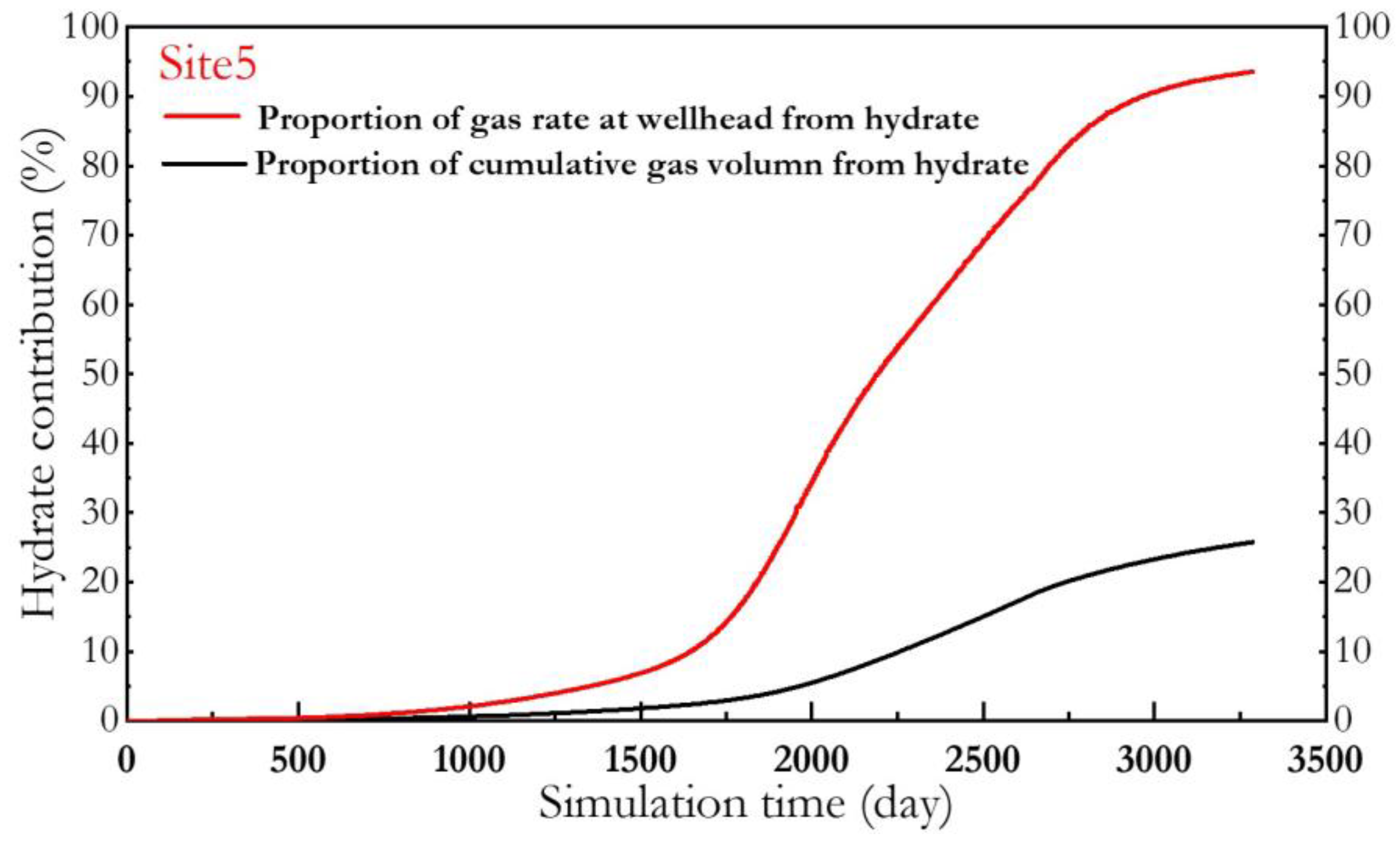

| Well Location | Production Scheme | Simulation Time | Description |
|---|---|---|---|
| Site 1 | Differential pressure 15 MPa | 9 years | Hydrate zone, all perforated |
| Site 2 | Differential pressure 15 MPa | 9 years | Hydrate zone, all perforated |
| Site 3 | Constant gas rate 20 × 104 m3/d | 9 years | Transition zone, all perforated |
| Constant gas rate 30 × 104 m3/d | 9 years | ||
| Constant gas rate 40 × 104 m3/d | 9 years | ||
| Site 4 | Constant gas rate 20 × 104 m3/d | 9 years | Transition zone, water zone is not perforated |
| Site 5 | Constant gas rate 20 × 104 m3/d | 9 years | Gas zone, all perforated |
| Basic Parameters | Value | Basic Parameters | Value |
|---|---|---|---|
| Molecular weight ρm/kg/mol | 119.543 | Mass density ρ/kg/m3 | 919.7 |
| Decay rate λd/mol/(day·kPa·m2) | 1.07 × 1013 | Formation rate λf/mol/(day·kPa·m2) | 2.5 × 105 |
| Activation energy E/J/mol | 81,084.2 | Specific area AHS/m2/m3 | 3.75 × 105 |
| Reaction enthalpy H/J/mol | 51,858 | Grain density ρR/kg/m3 | 2650 |
Disclaimer/Publisher’s Note: The statements, opinions and data contained in all publications are solely those of the individual author(s) and contributor(s) and not of MDPI and/or the editor(s). MDPI and/or the editor(s) disclaim responsibility for any injury to people or property resulting from any ideas, methods, instructions or products referred to in the content. |
© 2023 by the authors. Licensee MDPI, Basel, Switzerland. This article is an open access article distributed under the terms and conditions of the Creative Commons Attribution (CC BY) license (https://creativecommons.org/licenses/by/4.0/).
Share and Cite
Yu, L.; Lu, H.; Zhang, L.; Xu, C.; Kuang, Z.; Li, X.; Yu, H.; Wang, Y. Assessment of Gas Production from Complex Hydrate System in Qiongdongnan Basin of South China Sea. Energies 2023, 16, 7447. https://doi.org/10.3390/en16217447
Yu L, Lu H, Zhang L, Xu C, Kuang Z, Li X, Yu H, Wang Y. Assessment of Gas Production from Complex Hydrate System in Qiongdongnan Basin of South China Sea. Energies. 2023; 16(21):7447. https://doi.org/10.3390/en16217447
Chicago/Turabian StyleYu, Lu, Hongfeng Lu, Liang Zhang, Chenlu Xu, Zenggui Kuang, Xian Li, Han Yu, and Yejia Wang. 2023. "Assessment of Gas Production from Complex Hydrate System in Qiongdongnan Basin of South China Sea" Energies 16, no. 21: 7447. https://doi.org/10.3390/en16217447






